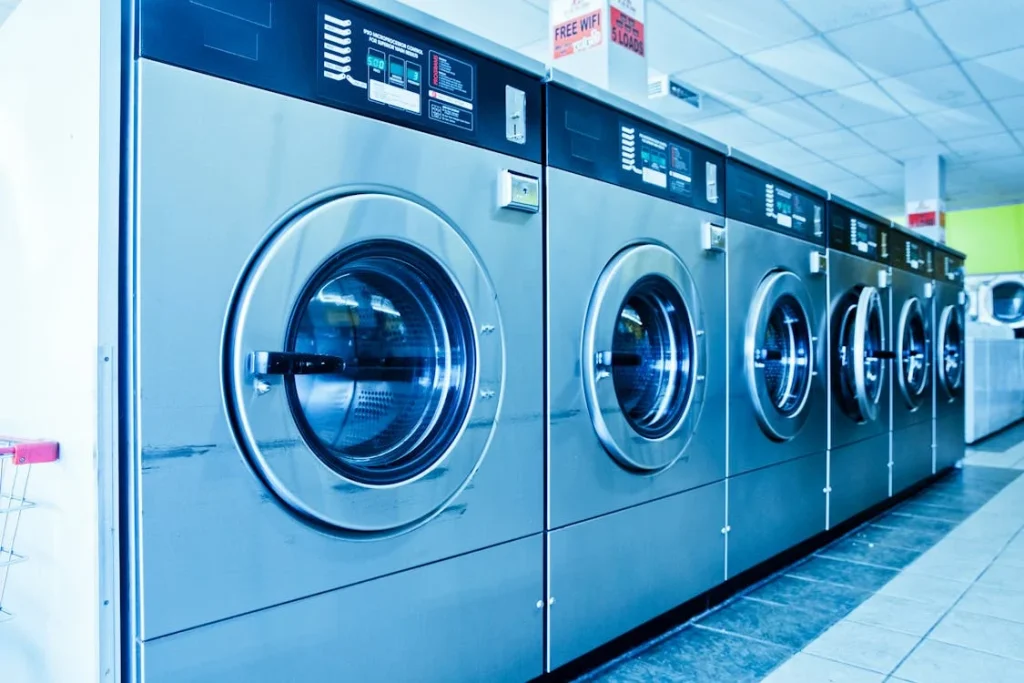When you think of washing machines, the first thing that probably comes to mind is the typical home appliance that takes care of your laundry. But industrial washing machines are an entirely different breed. These powerful machines play a crucial role in various industries like healthcare, hospitality, and manufacturing. Today, we’ll explore some interesting facts about these machines and uncover how they are designed to handle the challenges of large-scale laundry.
Tabla de contenidos
- 1. Introduction to Industrial Washing Machines
- 2. The History of Industrial Washing Machines
- 3. Fun Facts about Industrial Washing Machine
- 4. How Industrial Washing Machines Work
- 5. Technological Innovations in Washing Machines
- 6. Environmental Impact of Industrial Washing Machines
- 7. Industrial Washing Machines vs. Household Washers
- 8. Future Trends in Industrial Washing Machines
- 9. Conclusion
- 10. FAQs
1. Introduction to Industrial Washing Machines

1.1. What Are Industrial Washing Machines?
Industrial washing machines are heavy-duty appliances designed for large-scale laundry tasks. Unlike home washers, they are built to handle high-volume laundry loads and provide faster, more efficient washing solutions. From hospitals and hotels to factories and laundromats, these machines are essential in industries that require consistent, quick cleaning of linens, uniforms, and other textiles.
These washers can handle different fabrics, large amounts of detergent, and extended washing cycles—all while operating with more power and efficiency than typical residential machines.
2. The History of Industrial Washing Machines
2.1. The Evolution of Laundry Technology
Industrial washing machines have come a long way since their inception. Early laundry practices involved hand washing and manual scrubbing, which was time-consuming and labor-intensive. But with the advent of technology, mechanical washers started appearing in the late 19th century, revolutionizing the way industries handled laundry.
By the mid-20th century, washing machines began to evolve into fully automatic machines, with better controls and faster cycles. These improvements dramatically changed how large institutions handled high-volume laundry, leading to the need for even more powerful machines as industries grew.
2.2. Early Models and Innovations
In the early days, industrial washing machines were often manual or semi-automatic, meaning workers had to be hands-on throughout the washing process. However, as technology progressed, electric models began to emerge, reducing labor and speeding up the washing process. These early electric washing machines were quite large and typically installed in commercial laundromats or service industries that required bulk washing.
2.3. The Rise of Automation in Laundry
Automation became a game-changer in the industrial laundry industry. By introducing programmable control systems, manufacturers made it possible for machines to handle washing, rinsing, and spinning with minimal human intervention. This allowed businesses to increase efficiency, reduce labor costs, and create a more streamlined laundry process.
3. Fun Facts about Industrial Washing Machine
3.1. Capacity and Load Size
Industrial washing machines are available in a wide range of capacities, from small machines that can handle a few pounds of laundry to large machines that can handle hundreds of pounds. The capacity of the machine you need will depend on the size of your laundry loads and the frequency of your laundry needs.
3.2. Water and Energy Efficiency
Modern industrial washing machines are designed to be more water and energy efficient than older models. This can help to reduce operating costs and minimize the machine’s environmental impact.
3.3. Detergent and Chemical Compatibility
It’s important to use the right detergents and chemicals with your industrial washing machine. Some detergents and chemicals can damage the machine or leave residue on the laundry.
3.4. Maintenance and Upkeep
Proper maintenance and upkeep are essential for ensuring that your industrial washing machine operates efficiently and reliably. This includes regular cleaning, inspections, and repairs.
3.5. Safety Features and Regulations
Industrial washing machines are equipped with a variety of safety features to protect users and prevent accidents. There are also regulations in place to ensure that these machines are operated safely and responsibly.
3.6. Noise Reduction Technology
Noise reduction technology is becoming increasingly important in industrial washing machines. This technology can help to reduce noise levels and make the machines more pleasant to operate in.
3.7. Environmental Impact and Sustainability
Industrial washing machines can have a significant environmental impact. However, there are steps that can be taken to minimize this impact, such as using energy-efficient machines and reducing water consumption.
3.8. Cost and ROI
The cost of an industrial washing machine can vary depending on the size, features, and brand. However, these machines can be a worthwhile investment for businesses that need to process large quantities of laundry.
4. How Industrial Washing Machines Work
4.1. Components and Mechanisms
Industrial washing machines are more complex than household models, and their design reflects the need for large-scale washing. These machines usually feature a large drum, a powerful motor, and various control systems to regulate the wash cycle.
The drum is designed to hold large loads of textiles, while the motor ensures efficient agitation and spinning. Many industrial washers come with multi-functional control panels, allowing operators to adjust settings for different types of laundry loads.
4.2. The Role of Drum and Agitation
The drum in industrial washing machines plays a key role in cleaning fabrics. It’s designed to spin and agitate textiles, which helps to remove dirt and stains more effectively than household machines. This process mimics the scrubbing action of hand washing but on a much larger scale.
The agitation feature helps to evenly distribute detergent, water, and other cleaning agents throughout the fabric, ensuring that each load comes out fresh and clean.
4.3. Water and Detergent Usage in Machines
Industrial washing machines are designed to be efficient with both water and detergent usage. These machines often feature advanced systems that help optimize water flow and detergent distribution, allowing businesses to use less water while still achieving excellent cleaning results. Some modern models come with sensors that detect the soil level of fabrics, adjusting the water usage accordingly.
4.4. The Control Systems of Industrial Machines
Modern industrial washing machines come equipped with programmable control systems that offer flexibility in operation. These controls allow users to choose different wash cycles based on the type of load—whether it’s delicate fabrics, heavily soiled items, or regular laundry.
Advanced models even offer remote monitoring, allowing operators to track machine performance and troubleshoot problems from a distance.
5. Technological Innovations in Washing Machines
5.1. Smart Features in Modern Machines
Technology is constantly advancing, and so are industrial washing machines. Today’s machines are often equipped with smart features that increase their efficiency and reduce their environmental impact. These features include touchscreen controls, Wi-Fi connectivity, and automatic load balancing.
For example, some machines are able to connect to cloud-based systems, which allows for better monitoring and management of washing operations. This means faster response times to issues and more efficient machine usage.
5.2. Energy Efficiency Improvements
In today’s world, energy efficiency is a top priority. Modern industrial washing machines have been designed to save both water and energy. These machines often feature eco-friendly modes that use less water and energy while still delivering top-notch cleaning results. Some systems even recycle water, further reducing environmental impact.
6. Environmental Impact of Industrial Washing Machines
6.1. Reducing Water Waste and Energy Consumption
The laundry industry is notorious for its high water and energy consumption, which is why innovations in industrial washing machines are crucial for sustainability. Many industrial washing machines are now designed to use less water while providing the same cleaning power. By utilizing advanced sensors and control systems, these machines can detect the fabric type and adjust the water and energy levels accordingly.
6.2. The Role of Industrial Laundry in Wastewater Treatment
Another interesting fact is that many industrial washing machines play a role in wastewater treatment. Some washing machines are designed to filter and treat wastewater before it is released, minimizing the impact on the environment. This process helps ensure that laundry operations are sustainable and eco-friendly.
7. Industrial Washing Machines vs. Household Washers
7.1. Washing Power and Speed
The most noticeable difference between industrial and household washing machines is the power and speed of their cycles. Industrial machines are designed to wash larger loads more quickly. They are built to handle bulky items like linens, uniforms, and towels, which require more power to clean thoroughly.
7.2. Size and Capacity
Industrial washing machines are far larger than residential models, often with a much greater load capacity. These machines are built to handle up to 200 pounds or more of laundry, while household washers typically max out around 20-25 pounds.
8. Future Trends in Industrial Washing Machines
8.1. The Role of AI and Machine Learning
The future of industrial washing machines lies in automation and artificial intelligence (AI). AI can optimize washing cycles, predict maintenance needs, and even manage water usage more efficiently. Machine learning algorithms will allow washing machines to “learn” from previous loads, fine-tuning the washing process for improved results.
8.2. The Move Towards Fully Automated Laundry Systems
As industries continue to grow, the move towards fully automated laundry systems is becoming a reality. These systems can handle all aspects of laundry management, from washing and drying to sorting and folding. This future trend could revolutionize the laundry industry, providing businesses with even greater efficiency and cost savings.
9. Conclusion
Industrial washing machines have come a long way from their humble beginnings, evolving into sophisticated, high-performance machines that are integral to various industries. With their durability, energy efficiency, and advanced technological features, they continue to play a critical role in keeping operations running smoothly.
Are you looking for high-quality industrial washing machines for your business? Don’t hesitate to contact us for more information!
10. FAQs
1. How long do industrial washing machines last?
Industrial washing machines can last anywhere from 10 to 20 years, depending on usage and maintenance.
2. What industries use industrial washing machines?
They are commonly used in healthcare, hospitality, manufacturing, and commercial laundromats.
3. Can industrial washers save energy?
Yes, modern machines are designed to be energy-efficient, with features like load sensors and eco-friendly wash cycles.
4. Are industrial washing machines easy to maintain?
Yes, with regular servicing and maintenance, industrial washing machines are reliable and easy to maintain.
5. What’s the difference between an industrial washer and a commercial one?
Industrial washers are typically larger, more powerful, and designed for continuous, heavy-duty usage, while commercial machines are smaller and may have lower load capacities.
Here are some other articles that we think might interest you:
Environmental Impact of Industrial Laundry


